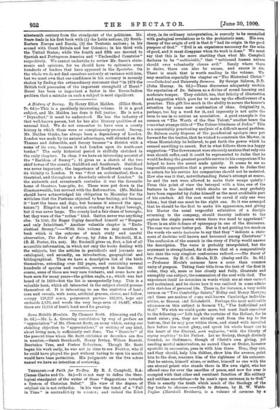A History of Surrey. By Henry Elliot Malden. (Elliot Stock.
7s. 6d.)—This is a peculiarly interesting volume. It is a good subject, and Mr. Malden has done it full justice. He is not a " Dryasdust," it must be understood. He has the industry of that well-known person, but he has also literary qualities of an unusual kind. We da not remember to have seen a county history in which these were so conspicuously present. Surrey, Mr. Malden thinks, has always been a dependency of London. London was made by it natural advantages, well situated on the Thames and defensible, and Surrey became "a district with a name of its own, because it had London upon its north-east border." The early historical period is skilfully sketched in tho early chapters. In chap. 9 we have an interesting account of the "Earldom of Surrey "; 11 gives us a sketch of the two chief towns of the county, Guildford and Southwark. Guildford was never important ; the importance of Southwark came from its Vicinity to London. It was "first an ecclesiastical, then a theatrical, and throughout a disorderly suburb of London." In the sixteenth and seventeenth centuries it was the favourite home of theatres, bear-pits, 8:e. These were put down in the Commonwealth, but revived with the Reformation. (Mr. Malden shoUld have acknowledged his obligation to Macaulay for the witticism that the Puritans objected to bear-baiting, not because it "hurt the bears and . dogs, but because it amused the spec_ tators.") Ringston had a certain standing as a Royal borough, but it was never large. The county had a fair share of boroughs, but they were of the " rotten " kind. Gatton never was anything else. ' In 1541, Sir Roger Copley described himself as "Burgess and only Inhabitant." Another valuable chapter is "Eccle- siastical Surrey."—With this volume we may mention a book which is the outcome of much study and careful observation, The Birds of Surrey, by John A. Bucknill, M.A. (B. .H. Porter, 21s. net). Mr. Bucknill gives us, first, a list of all accessible information, in which not only the books dealing with the subjects, but the articles in periodicals and journals are catalogued, and secondly, an introduction, geographical and bibliographical. Then we have a descriptive list of the birds themselves, extending over 352 pages, and containing several hundreds of species and varieties, arranged in families. Of course, some of these are very rare visitants, and some have not been seen for many years—the golden eagle, e.g., which was last heard of in 1310—but the list is unexpectedly long. This is a valuable book, which all interested in the subject should possess themselves of. It is interesting to see the statistics of land ; corn and cereals, with roots, artificial grasses, clover, and fallow, occupy 128,257 acres, permanent pasture 152,593, hops and orchards 2,876, and woods the very large area of 51,437, while there are 11,850 of heath land used for grazing.


















































 Previous page
Previous page